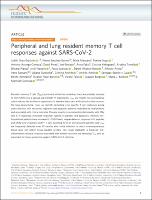Peripheral and lung resident memory T cell responses against SARS-CoV-2

View
Author
Date
2021-05-21Permanent link
https://hdl.handle.net/11351/6828DOI
10.1038/s41467-021-23333-3
ISSN
2041-1723
WOS
000658765200007
PMID
34021148
Abstract
Resident memory T cells (TRM) positioned within the respiratory tract are probably required to limit SARS-CoV-2 spread and COVID-19. Importantly, TRM are mostly non-recirculating, which reduces the window of opportunity to examine these cells in the blood as they move to the lung parenchyma. Here, we identify circulating virus-specific T cell responses during acute infection with functional, migratory and apoptotic patterns modulated by viral proteins and associated with clinical outcome. Disease severity is associated predominantly with IFNγ and IL-4 responses, increased responses against S peptides and apoptosis, whereas non-hospitalized patients have increased IL-12p70 levels, degranulation in response to N peptides and SARS-CoV-2-specific CCR7+ T cells secreting IL-10. In convalescent patients, lung-TRM are frequently detected even 10 months after initial infection, in which contemporaneous blood does not reflect tissue-resident profiles. Our study highlights a balanced anti-inflammatory antiviral response associated with a better outcome and persisting TRM cells as important for future protection against SARS-CoV-2 infection.
Keywords
Cellular immunity; Infectious diseases; Viral infection; Coronavirus SARS-CoV-2; COVID-19; 2019-nCoVBibliographic citation
Grau-Expósito J, Sánchez-Gaona N, Massana N, Suppi M, Astorga-Gamaza A, Perea D, et al. Peripheral and lung resident memory T cell responses against SARS-CoV-2. Nat Commun. 2021 May 21;12:3010.
Audience
Professionals
This item appears in following collections
- Col·lecció especial COVID-19 [945]
- HVH - Articles científics [4476]
- VHIR - Articles científics [1751]
The following license files are associated with this item:

 Private area
Private area Contact Us
Contact Us







